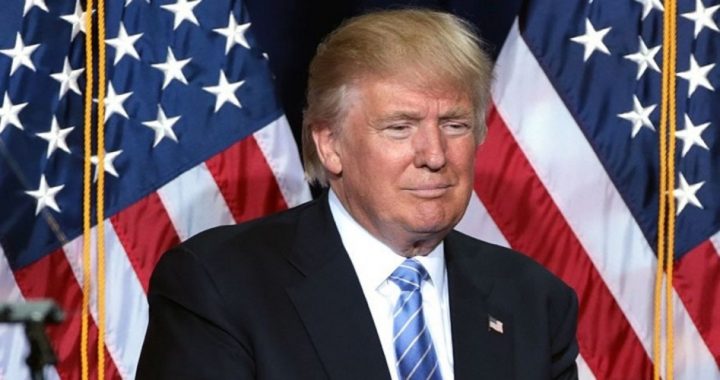
In an apparent response to media reports suggesting that President-elect Donald Trump had reneged on his campaign promise to make Mexico pay for his proposed wall along the U.S.-Mexican border, Trump tweeted a message in the early hours of January 6 that called the media “dishonest” and said he would still get Mexico to pay back the cost of the wall.
Among the news sources that had reported on talks between Trump’s transition team and congressional leaders about how to pay for the wall, was CNN, which ran a story on the evening of January 5 reporting that Trump’s team wants to ask Congress for money to construct the wall. An update of that report the following day stated:
President-elect Donald Trump’s transition team has signaled to congressional Republican leaders that his preference is to fund the border wall through the appropriations process as soon as April, according to House Republican officials.
The move would break a key campaign promise when Trump repeatedly said he would force Mexico to pay for the construction of the wall along the border, though in October, Trump suggested for the first time that Mexico would reimburse the US for the cost of the wall.
In response to this and similar media reports, Trump tweeted:
The dishonest media does not report that any money spent on building the Great Wall (for sake of speed), will be paid back by Mexico later!
As was noted in an article posted by The New American last November, though the building of a wall along the U.S.-Mexico border was perhaps the most controversial plank of Trump’s immigration platform, Kris Kobach, the secretary of state of Kansas and one of the president-elect’s transition advisors, said the plan for the wall is moving forward.
“There’s no question the wall is going to get built. The only question is how quickly will it get done and who pays for it,” the article quoted Kobach as saying.
The report noted that the first item on Trump’s “10 Point Plan to Put America First” under the immigration section of his campaign website was: “Begin working on an impenetrable physical wall on the southern border, on day one. Mexico will pay for the wall.”
The article’s writer, Joe Wolverton, summarized his report by stating: “There’s no doubt that his experience in drafting and defending strict immigration legislation [as the secretary of state of Kansas] will help Kris Kobach construct and carry out President-elect Trump’s broad plan of clamping down on the number of immigrants crossing the southern border.”
Given the difficulties in getting Mexico to pay for the wall directly — and Mexican President Enrique Pena Nieto’s statement that his country would not pay for it — Trump has floated some ways to collect the cost indirectly. Some of these options were discussed in an article posted by The New American last September. The article quoted the Weekly Standard, which cited statements made during a speech at the Hudson Institute in Washington last September by Jorge Castañeda, who was Mexico’s secretary of foreign affairs from 2000 to 2003 and is now a New York University professor:
“If [Trump] really wants Mexico to pay for the wall, he has many ways of getting many Mexicans to pay for the wall,” Castañeda said in an auditorium sitting directly across the street from Trump’s newly opened Pennsylvania Avenue hotel.
He could “increase the fee for visas, which is a decision made by the State Department, not by Congress,” Castañeda continued. He could “increase the toll on the bridges [between the two countries] … again, not done by Congress.”
Castañeda also suggested that Trump could tax remittances from the U.S. to Mexico: “There are ways of doing it,” he said, “transaction fees, commissions, special fees etc.”
Lately, however, Trump’s advisors and Republican allies in Congress have reportedly been discussing the option of having the United States paying for the construction of the wall up front, and then figuring out how to collect the payment for it from Mexico later.
The AP reported that Trump transition spokesman Sean Spicer said following such a plan “doesn’t mean [Trump has] broken his promise.” In an interview on January on ABC’s Good Morning America, Spicer said: “I think [Trump is] going to continue to talk to them [the Mexican government] about that.”
A report in Politico observed that even before the election Trump had discussed having the United States pay for the wall initially and then getting the money back from Mexico afterwards. He said in a speech in late October in Gettysburg, Pennsylvania, that his promised border wall would be funded by legislation, but urged his supporters not to worry because such a law would be passed “with the full understanding that the country of Mexico will be reimbursing the United States for the full cost of such a wall.”
As to how the administration would get the money from Congress to pay for the construction, Bloomberg, in a January 6 report, cited a statement from House Republican Policy Committee Chairman Luke Messer (Indiana) that Republicans in Congress and Trump transition team members are considering using a law signed by former President George W. Bush that authorized construction of more than 700 miles of “physical barrier” on the U.S.-Mexican border. That 2006 law was never fully implemented and didn’t include a sunset provision.
The Republican leadership is also considering whether to include border security funding in a stopgap spending bill that must be enacted by the end of April to keep the federal government funded. That strategy might provoke a showdown with Democrats over funding, putting them in the position of voting to shut down the government to put a roadblock in front of Trump’s fulfillment of a campaign pledge to build the wall.
“It’s not a silver-bullet solution to border security, but it’s certainly a good start,” Messer said in an interview.
The ultimate solution might not be a wall along the entire southern border, but a wall in some places, and fences and motion detectors elsewhere along the border.
“It could be a mix of things,” Messer said.
Related articles:
Trump Transition Immigration Advisor: Wall Will Be Built
Ex-Mexican Official: Trump Can Make Mexico Pay for Wall, Si!



